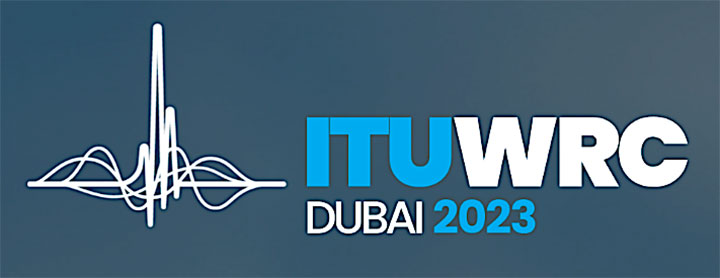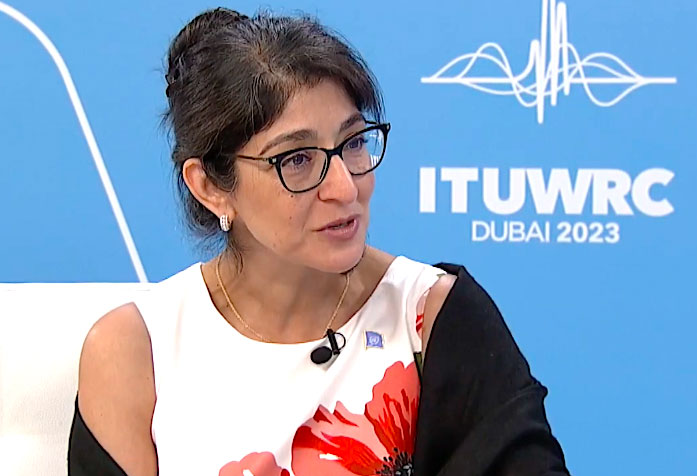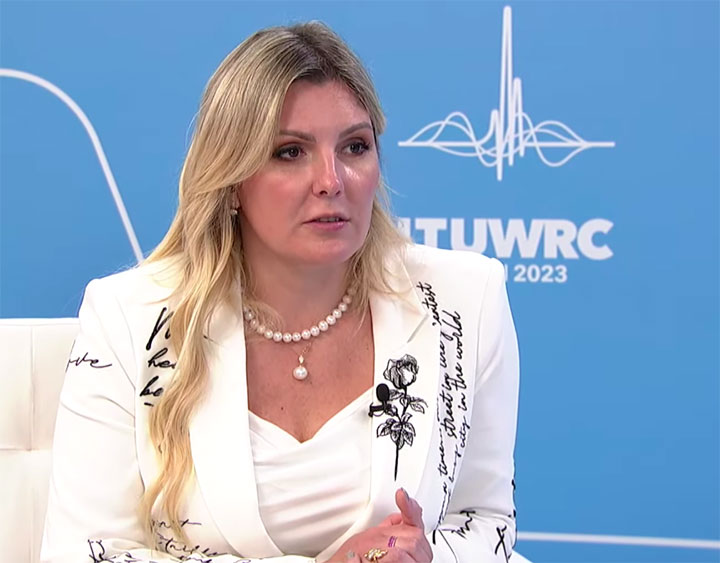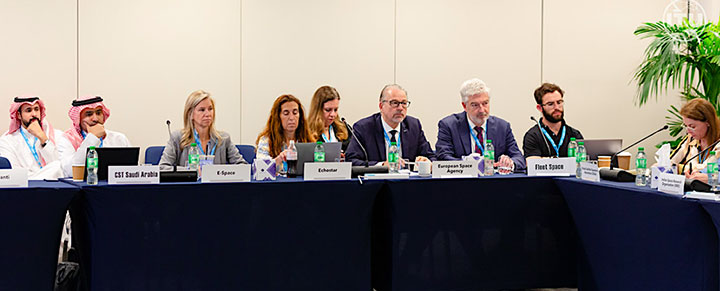 (Source: WRC-2023)
(Source: WRC-2023)
LA PLATA, Maryland — Two United Nations agencies appealed to international telecommunications regulators to block attempts by terrestrial mobile interests to get access to spectrum used by high-resolution radar satellites to assess climate change.
The Office of Outer Space Affairs (OOSA) and the World Meteorological Organization (WMO) are among the 200-plus agencies and companies attending the International Telecommunication Union (ITU) World Radiocommunication Conference (WRC-23) that runs Nov. 20-Dec. 15 in Dubai.
The debate over the 10-GHz spectrum use by synthetic-aperture radar satellites, with ground resolutions as sharp as 25 centimeters, is one of several, including C- Ku- and Ka-band, at WRC-23 where the satellite sector is attempting to keep satellite-allocated spectrum out of the reach of terrestrial mobile.
It was eight years ago, at WRC-15, that ITU delegations agreed to double the amount of spectrum allocated to radar Earth observation measurements, to 1,200 MHz. The new spectrum resulted in higher-resolution imagery.
 Aarti Holla-Maini, director, UN Office of Outer Space Affairs. (Source: ITU video)
Aarti Holla-Maini, director, UN Office of Outer Space Affairs. (Source: ITU video)
“These radar images are instrumental in supporting not only early-warning networks, but also applications areas such as environmental monitoring, deforestation, water management, illegal fishing, sustainable agriculture and disaster management,” said Aarti Holla-Maini, director of OOSA, in an address to the WRC-23 conference.
“A reversal of the WRC-15 decision now would simply remove our ability to access this high-resolution imagery, leaving us with no alternative whatsoever.”
Holla-Maini used the example of Lake Chad, located in western and central Africa, whose water level has been decreasing. The declining water levels can be imaged by medium-resolution satellites, “but you cannot see the single road that is used to drive deforestation equipment into the forest before they start deforesting in masse,” Holla-Maini said.
“With high-resolution imagery, you can actually see when a blade of grass is at its three-shoot stage, its most optimum in terms of feed and nutrition.”
 WMO Director Natalia Dohono. (Source: ITU)
WMO Director Natalia Dohono. (Source: ITU)
WMO Director Natalia Dohono said the organization is at WRC-23 for similar reasons.
“The WMO Integrated Global Observing System is critically dependent on radio frequencies, Dohono said in an interview done by the ITU. “Protection of portions of spectrum is critical for sea-surface temperature and microwave observations from space. We urge administrations to take account of Earth observing systems in specific frequency bands. They are vital for protecting life and property.”
The ITU, OOSA and WMO are all United Nations agencies. The fact that the ITU may go in a direction deemed harmful to missions of OOSA and WMO is an example of how government bodies get in the way of their own objectives.
Telecom regulators, space agencies need to talk to each other
The same is true for the wider issue of space “sustainability,” meaning space traffic management, space domain awareness, debris mitigation and collision avoidance.
The agencies with the power to license satellites are the telecom regulators at ITU and its member nations.
The agencies with the most knowledge of the issues are at OOSA, WMO and, importantly, at the space agencies. These bodies do not often mingle with the ITU.
But that is changing. The ITU has begun an outreach program with NASA and the 22-nation European Space Agency (ESA).
 The ITU’s Dec. 3 roundtable on space connectivity and sustainability featured a large number of commercial satellite fleet operators. But European Space Agency Director-General Josef Aschbacher was also there, seated between EchoStar and Fleet Space. (Source: ITU)
The ITU’s Dec. 3 roundtable on space connectivity and sustainability featured a large number of commercial satellite fleet operators. But European Space Agency Director-General Josef Aschbacher was also there, seated between EchoStar and Fleet Space. (Source: ITU)
The ITU on Dec. 3 held a roundtable on space connectivity and sustainability featuring a large number of commercial satellite operators including Amazon, SpaceX, Intelsat, Planet, EchoStar, Viasat and SoftBank. Notable among them: ESA Director-General Josef Aschbacher.
“The ITU convenes national telecoms regulators, while OOSA, through Copuos (the Committee on the Peaceful Uses of Outer Space) convenes the space agencies and space experts from foreign ministries or ministries of science and education,” Holla-Maini said.
“They don’t necessarily talk together. The ITU-R cares about space sustainability to assure the rational, efficient use of spectrum and avoid harmful interference. The risk of that is increasing with the thousands of satellites set to be launched in the future,” Holla-Maini said.
“Telecoms regulators… want to know: How should they license non-geostationary satellite services within their territories to manage the risks associated with space sustainability? They want to regulate, but they don’t necessarily know what the rules are that they should put into place — precisely the rules that Copuos delegates have been reflecting long and hard over for the past decade.
“Silos unfortunately exist. It’s not necessarily obvious for a national telecoms regulator to be speaking with a space agency. It’s a mutual responsibility of both ITU and OOSA to bridge the gap.”
